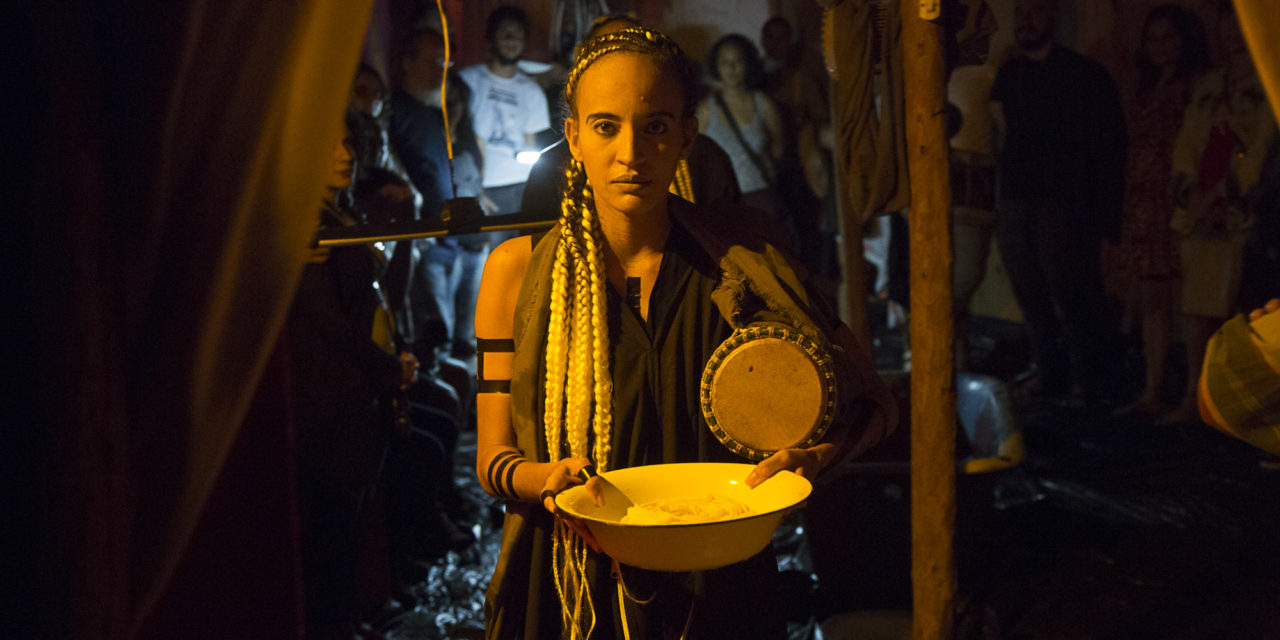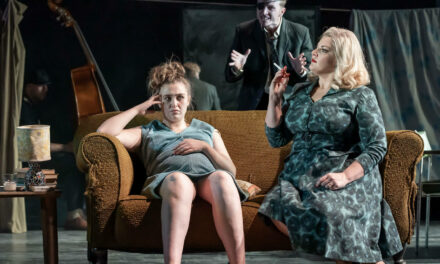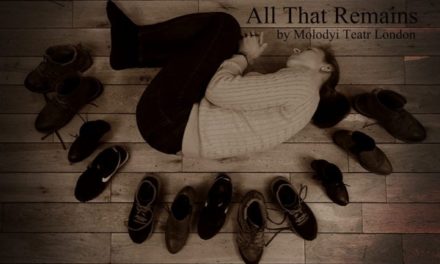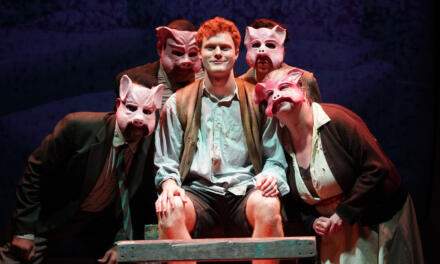In times of cognitive arrogance in contemporary reception, Quaseilhas is guided by the language of secrecy through its lexicon. Its statements are protected by idiomatic wisdom. In a western understanding, oríkìs would be literary scriptures that tell about the ancestral identity of an individual or community, and which function as the basis of what would be called the dramaturgical writing of this performance. The oríkìs are inscribed in Yorubá, challenging the Western reception that in general elects (or privileges) a selected group of languages in the literary articulation of their poetics. This idiomatic challenge presented by the performance Quaseilhas causes the spectator to access shortcuts in the process of reception-encounter with the staging.
To the extent that utterances can fail in the final and traditional cognition of speech acts (AUSTIN), Quaseilhas seems to make a conscious bet on the failure of the Western sovereignty of the word, investing at the same time in the phenomenon of the performativity of those speech acts. That is, although spoken in Yorubá, the staging doesn’t rest on the naive belief of the possibility of any spectator to know the language of the Niger-Congolese linguistic family and spoken by the majority in Nigeria, and by a minority in Benin, Togo, and Sierra Leone. Quaseilhas makes a precise bet on this gap. It goes against the theoretical counterpoint of speech acts, betting precisely on its vulnerability (JUDITH BUTLER). Where do we go when statements are presented in a communicative language challenge? Indeed, this question doesn’t arise in the moment-phenomenon in which we are watching this performance produced in the city of Salvador, Bahia, in Brazil. But that communicational vulnerability installed in Quaseilhas makes us regain our strength (in the face of the Western failure to understand any other language that isn’t in its bubble circle) in understanding signs that semiotic refers as first-time.
These shapes and colors promote relationships of sensations. And it is precisely what Quaseilhas articulates with the spectators, leading them from their sensations towards their feelings. The performance feeds on memories (oríkìs) hidden in the Yorubá language but emotionally relates to the memories-sensations of the spectator. This articulation makes each one watch and construct multiple layers of the play conducted by powerful signs of blackness. This process happens through stimulated feelings by the sensations of the encounter-experience with the offered sonority and visuality. Even though someone doesn’t understand the narrated memories from dramaturgical-oríkìs through the traditional, narrative way, the reception establishes a relational pact by the filling of memory and cognition gaps.
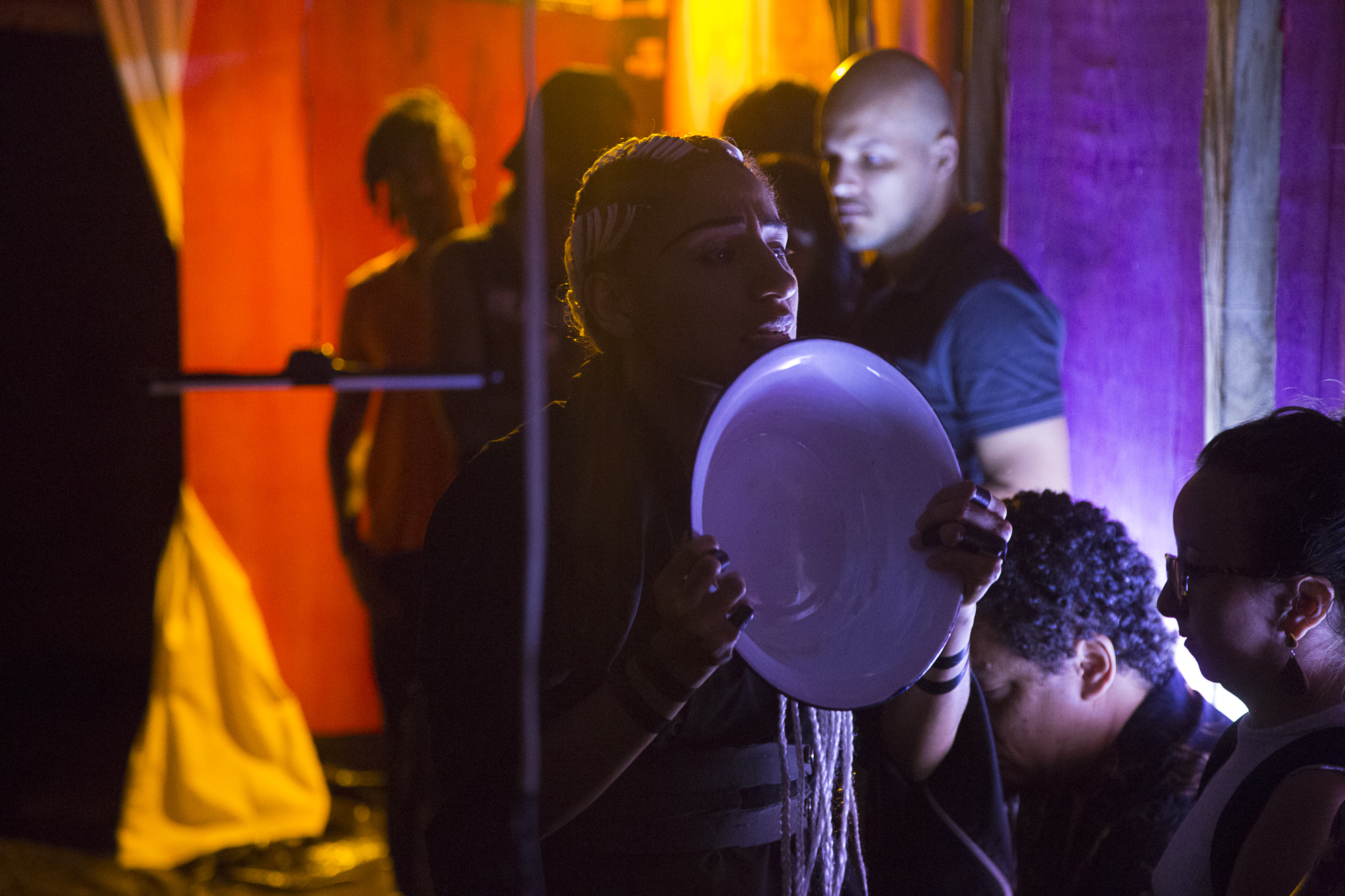
Nefertite Altan in Quaseilhas. Photo: Guto Muniz.
SPATIALITY AND SUBVERSION
Another strategy presented by Quaseilhas is its triple configuration in spatiality. It happens simultaneously in three separate rooms and the spectators cannot change rooms during the play. In the Camamu room, as a guiding object of our gaze, there is a bed with traditionally western aspects, denouncing its diasporic cultural crossroads (LEDA MARIA MARTINS) or double consciousness (W.E.B. DU BOIS). In the room called Pantaleon, where the audience remains standing, there is an old bathtub as a central axis of visuality. Although westernized in its form, it is installed in a way that we could consider non-western. Finally, in the Quebra-Machado room, we find another strongly western element, a tubular television, stuck on a floor that is completely covered with sand. In this room, (perhaps not by chance) we are forced to sit to watch. Since we have access to all of the sounds of the three rooms through a system of electronic microphonization, we conclude the spatial division is only simulated, as they are connected with extremely imagistic sonority.
Before entering, we have to choose from which of those rooms we want to watch the play. At that moment, we are taken by an impression that we will lose actions-images of the other rooms because of our choice. Later, touched by a typical spectator curiosity, we perceive the sounds-images that escape from the other spaces. From the texture of those sounds, electronically captured from the rooms, signs emerge randomly as if they were echoes of a distant time-space. As voices of a lost ancestry hidden in a language turned primitive by official instances of Western historiography–as Wilhelm Hegel wrote in his Philosophy of History, that postulates Africa as a un-historiographable object.
Quaseilhas is divided into three places…almost as a possible reference to the Berlin Conference (1885), when European leaders artificially redrew the border features of an ancient and African territory/culture. But unlike the fateful and strategic Conference of the late nineteenth century, Quaseilhas is configured in a generous way, considering the sounds-images of the other rooms (which we are not in) are offered to us, and they adjust in a sensorial way with the chosen room. The game of cultural crossroads and double-consciousness identified in the Western elements mentioned above in the scenography (and also in the electronic articulation mode of sounds and music performed by a band located in a room partially invisible to the viewers) seems to be the visual keynote of these rooms/installations.
In a superficial constitution of understanding, we could rely on a vision that the room divisions refer to the rooms of a house made of stilts of the district of Alagados (in Salvador, Bahia) that used to be constructed over the sea, challenging structures of engineering, and depending on the high and low tide inclement of the weather. The stilt houses (which no longer exist in Salvador) were imposed as proper small islands of disorder–not in the sense of German playwright Heiner Mueller, but as responses to the deterritorialization of some segments of civil society weakened by the orders of capital. In a Western point of view, the word “subversion” would not be suited to these house structures. Perhaps they were almost subversive, semantically shaped like “almost islands” (the Portuguese meaning for Quaseilhas), by their defiantly fluctuating structures. The staging uses this historical reality of Salvador, entirely populated by diasporic black people, to articulate the identity and ancestral research of the dramaturgic-oríkìs of its author-director, Diego Pinheiro, a former resident of those almost subversive stilt houses. The spatially triple constitution imposes this sensation on the viewers, even if they are not traditionally and cognitively connected with this information-statement.
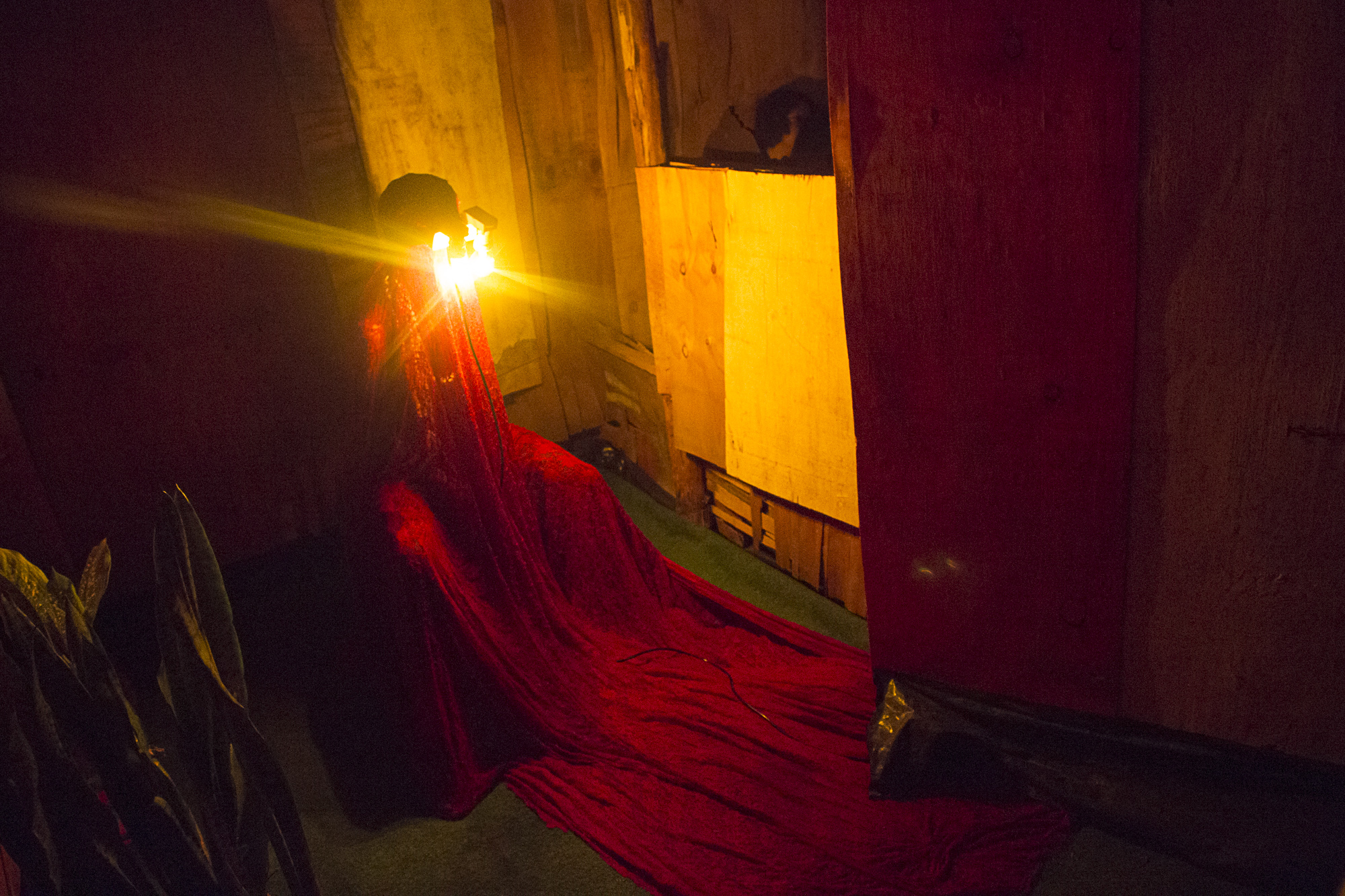
Laís Machado in Quaseilhas. Photo: Guto Muniz.
AFROFUTURISM
Another disturbance provoked by this performance is the aesthetic dialogue with what we call Afrofuturism (MARK DERY). The antinomy between the object-memory that traditionally tends to throw us towards a narrative of the past, and the Afrofuturism that imposes itself in the scene of Quaseilhas, promotes yet another challenge to the audience, who is impelled to re-signify the blackness that is so commonly associated (in the arrogant wing of the analytic contemporaneity) to a primitive and regressed figural. In 2018, the symbolic speed of Afrofuturism–which emerged in the sixties simultaneously with the positive noise of the beatnik (HERB CAEN)–crosses the Bahian performance Quaseilhas, sealing the complex temporal articulation of the narrative that associates past, present and future through Yoruban oríkìs of his author-director. One can perceive the power (and urgency) of dramaturgy written in the grammatical first person of the black diasporic artists. Blackness is not here as an object, but as a subject (MAKOTA VALDINA) of a narrative. What we see is the displacement of understanding of the black-diasporic figural as the driver of its own history, generously allowing the (Western and non-Western) world to experience the almost sense-feeling of the Diaspora existence and its cultural reference crossroads legitimized by historiographed displacements of peoples.
Bibliography
AUSTIN, J.L. How To Do Things With Words – The William James Lectures Delivered at Harvard University in 1955. London: Oxford University Press, 1962.
BUTLER, Judith. Excitable Speech: A Politics Of The Performative. New York/London: Routledge, 1997.
DUBOIS, W. E. Buhrgardt. The Soul Of The Black Folks. Millenium Publications, 2014.
HEGEL, G. W. F. A Filosofia Da História. Petropólis: Vozes, 1997. 2 vols.
MARTINS, Leda Maria. A Cena Em Sombras. Editora Perspectiva: São Paulo, 1995.
AUTHOR: Aldri Anunciação
This post was written by the author in their personal capacity.The opinions expressed in this article are the author’s own and do not reflect the view of The Theatre Times, their staff or collaborators.
This post was written by Aldri Anunciação.
The views expressed here belong to the author and do not necessarily reflect our views and opinions.

